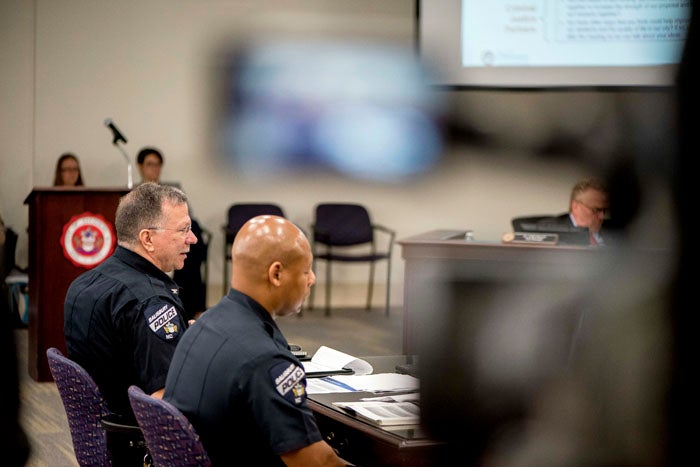Department of Justice, Salisbury police come up with solutions
Published 2:55 pm Tuesday, August 14, 2018

- JON C. LAKEY / SALISBURY POST The Office of Justice Program Diagnostic Center and Salisbury Police department's Chief Jerry Stokes (left) reported Salisbury City Council on a recent assessment of its internal capabilities, violent crime trends, reduction strategies and community engagement efforts in 2017. on 8/14/18 at in Salisbury, NC.
By Shavonne Walker
shavonne.walker@salisburypost.com
SALISBURY — After a months-long assessment by the U.S. Department of Justice Programs’ Diagnostic Center, the Salisbury Police Department has been able to work toward implementing some programs and strategies to reduce gun violence.
In November 2017, the Salisbury Police Department reached out to the Office of Justice Programs’ Diagnostic Center to help the police department assess what works in preventing and controlling crime. The Diagnostic Center has essentially helped the police implement data-driven programs to help reduce violent crime.
The Diagnostic Center worked with the community and law enforcement over a period of time to understand what the issues were related to crime. The center collected dataand provided analysis and recommendations. The center also identified training and technical assistance to support the implementation of those recommendations.
The assessment included interviews with law enforcement agencies that partner with the police department, faith-based leaders, neighborhood representatives and business owners.
There were three priority areas identified through the assessment:
• Understand violent crime trends and factors.
• Assess Salisbury Police Department’s response strategies to violent crime.
• Enhance citizen engagement efforts to reduce violent crime.
Strategies
• Violence prevention strategies targeted at urban youth.
Analysts said the common features of effective programs include the use of street outreach workers and connections with community services and support for high-risk youth. Some of the recommendations that were made include focusing on youth at the highest risk for future violence and communicating to targeted offenders that they will receive services to change their lifestyle.
• Gun violence reduction strategies for law enforcement.
Some of the strategies included looking at gun violence in “hot spots” or areas where crimes occur in clusters or in specific blocks. In addition, a small number of high-rate offenders commit shootings at specific places and times.
Victims or perpetrators in non-fatal shootings have a high-risk factors for future gun violence. The answer could lie in providing victim services and investigative resources focused on non-fatal shootings.
• Public prevention
Analysts said a cure for violence could lie in a public health approach — using trained street violence interrupters and outreach workers, public education campaigns and community mobilization to reduce shootings and killings.
The morning meeting was so that city council members and community members could hear about the findings and ask questions. Another public meeting will be held today at 5:30 p.m. at the Salisbury Civic Center, 315 S. Martin Luther King Jr. Ave.
See more in Wednesday’s Post about how analysts came up with these strategies and how the department has begun to implement a few of them.


